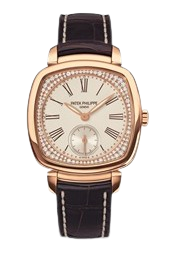
Royal Oak
AUDEMARS PIGUET ROYAL OAK
|
Originally introduced in 1972 and designed by Gerald Genta. The AP Royal Oak stands as the first luxury sports watch... to be constructed from stainless steel, the Royal Oak collection has achieved iconic status and is now considered to be Audemars Piguet's flagship model. The watches have unique aesthetic appeal, thanks to their unmistakable octagonal bezels, while the dials each feature a trademark “tapisserie” pattern, adding to the pure visual appeal. Today, many variants of the watch are available, with their own unique features. These models include the Royal Oak Chronograph, which offers three different counters, as well as date display, and is water resistant for up to 50 meters. Read more Show less |
Audemars Piguet Royal Oak Model History
|
Originally introduced back in 1972, the Royal Oak is widely recognised as the single most popular watch in the Audemars Piguet catalogue. When it was initially released, it represented a bold and daring step for the brand, but it enjoyed great success and has since gone on to become AP's flagship model. In terms of its design, although the watch combines sports watch and dress watch elements, it is less sporty than the Royal Oak Offshore collection and better suited to formal occasions. In this article, we take a more detailed look at the history of the Audemars Piguet Royal Oak, including some of the key changes throughout the years.
The first Royal Oak ModelDesigned by Gérald Genta, the first Royal Oak model was unveiled at the Baselworld Fair in 1972 and represented a significant break from the conventions of the time. In the midst of the Quartz crisis, Audemars Piguet relied on its watch-making prowess and talent for innovation, releasing what is regarded as the first 'luxury sports watch'. Visually, the model was defined by its octagonal bezel, fully integrated bracelet and a pattern on the dial, which has variously been described as 'waffle-print' and 'tapisserie'. However, perhaps its most significant feature was its stainless steel case material, which was considered something of a taboo for luxury brands at the time. The model, which would become known as the Reference 5402, was initially given a limited 1,000-piece release and it took over a year for the manufacturer to sell those 1,000 watches. However, sales then took off and thousands more models were released on general sale, with B and C-series serial numbers.
AP Royal Oak InnovationsWith the company's calculated risk paying off, the collection was expanded in 1981 with the release of the Royal Oak Perpetual Calendar. As the name suggests, the main change was the inclusion of a perpetual calendar function, meaning that no intervention was required to adjust the date display, regardless of leap years. This new model was also notable for being powered by the Calibre 2120/2800 movement, which was specifically designed to allow the watch to be the thinnest of its type in the world at that point. Meanwhile, the changes to the dial to accommodate the new calendar function gave it a slightly more sporty quality. A few years later, in 1984, AP released a slightly dressier alternative, in the form of the Royal Oak Day/Date Moonphase. The dial on this model was more in-keeping with the first Royal Oak model, but featured three sub-dials. Two of these displayed the day and the date, while the third was a moon phase indicator.
New Royal Oak CollectionDespite the 1993 release of the Royal Oak Offshore collection, which has a distinctly more sporty appearance, AP has remained faithful to its main Royal Oak line. Today, the Reference 15202, affectionately known as the Royal Oak 'Jumbo', is the most popular model in the collection, paying tribute to the original Royal Oak timepiece. Indeed, the watch makes use of the same Calibre 2121 movement that the 1972 model used and features a very similar case. In 2012, an updated version of the Reference 15202 was released, with subtle changes to the dial, such as the placement of the 'AP' initials, bringing it even closer in line with the original. With that being said, AP has also retained its reputation for innovation. For instance, in 2002, the company released the Royal Oak Concept; an ultra-robust version, which utilised alacrite 602, a superalloy more typically associated with aerospace engineering. Then, in 2010, Audemars Piguet released the Royal Oak Equation of Time, which featured a perpetual calendar, moon phase indicator, sunrise and sunset indicator and a solar time function.
|
Audemars Piguet Buying Guide
Audemars Piguet Royal Oak BEST SELLERS:
- 34mm - Audemars Piguet Royal Oak Watches
- 37mm - Audemars Piguet Royal Oak Watches
- 38mm - Audemars Piguet Royal Oak Watches
- 39mm - Audemars Piguet Royal Oak Watches
- Rose Gold & 41mm - Audemars Piguet Royal Oak Watches
- Rose Gold Chronograph 41mm - Audemars Piguet Royal Oak Watches
- Stainless Steel & 41mm - Audemars Piguet Royal Oak Watches
- Stainless Steel Chronograph 41mm - Audemars Piguet Royal Oak Watches
- Royal Oak Tourbillion - Audemars Piguet Watches
- Royal Oak Perpetual Calendar - Audemars Piguet Watches
- Royal Oak Openworked - Audemars Piguet Watches
- Royal Oak Double Balance Wheel - Audemars Piguet Watches
- Royal Oak Frosted Gold - Audemars Piguet Watches
- Special Edition - Audemars Piguet Watches
Audemars Piguet Royal Oak by Model Number:
- AP 26240OR - Audemars Piguet Royal Oak Watches
- AP 26240ST - Audemars Piguet Royal Oak Watches
- AP 26331OR - Audemars Piguet Royal Oak Watches
- AP 26320OR - Audemars Piguet Royal Oak Watches
- AP 26331ST - Audemars Piguet Royal Oak Watches
- AP 26320ST - Audemars Piguet Royal Oak Watches
- AP 15510 - Audemars Piguet Royal Oak Watches
- AP 15500 - Audemars Piguet Royal Oak Watches
- AP 15400 - Audemars Piguet Royal Oak Watches
- AP 15300 - Audemars Piguet Royal Oak Watches
Audemars Piguet Royal Oak Watches by Material:
- Rose Gold - Audemars Piguet Royal Oak Watches
- Yellow Gold - Audemars Piguet Royal Oak Watches
- White Gold - Audemars Piguet Royal Oak Watches
- Stainless Steel - Audemars Piguet Royal Oak Watches
- Rose Gold/Steel- Audemars Piguet Watches
- Steel/Diamonds - Audemars Piguet Royal Oak Watches
- Platinum - Audemars Piguet Royal Oak Watches
- Titanium - Audemars Piguet Royal Oak Watches
Audemars Piguet Watches by Size & Material:
- Stainless Steel & 41mm - Audemars Piguet Watches
- Stainless Steel & 38mm - Audemars Piguet Watches
- Stainless Steel & 37mm - Audemars Piguet Watches
- Yellow Gold & 41mm - Audemars Piguet Watches
- Yellow Gold & 37mm - Audemars Piguet Watches
- Rose Gold & 41mm - Audemars Piguet Watches
- Rose Gold & 38mm - Audemars Piguet Watches
- Rose Gold & 37mm - Audemars Piguet Watches
Audemars Piguet Royal Oak Watches by Dial Color:
- Blue Dial - Audemars Piguet Royal Oak Watches
- Black Dial - Audemars Piguet Royal Oak Watches
- Brown Dial - Audemars Piguet Royal Oak Watches
- White Dial - Audemars Piguet Royal Oak Watches
- Grey Dial - Audemars Piguet Royal Oak Watches
- Silver Dial - Audemars Piguet Royal Oak Watches
- Skeleton Dial - Audemars Piguet Royal Oak Watches
- Slate Dial - Audemars Piguet Royal Oak Watches
Audemars Piguet Royal Oak Watches by Generation:
- 2023-Current - Audemars Piguet Royal Oak Watches
- 2022-2023 - Anniversary Audemars Piguet Royal Oak Watches
- 2018-2022 - Audemars Piguet Royal Oak Watches
- 2012-2017 - Audemars Piguet Royal Oak Watches
- 2007-2012 - Audemars Piguet Royal Oak Watches
Audemars Piguet Royal Oak Chronograph Watches by Generation:
- 2023-Current - 26240 Audemars Piguet Royal Oak Watches
- 2021-2023 - 26240 Anniversary Audemars Piguet Royal Oak Watches
- 2017-2021 - 26331 Audemars Piguet Royal Oak Watches
- 2012-2017 - 26320 Audemars Piguet Royal Oak Watches
Audemars Piguet Royal Oak Watches by Model:
- Selfwinding - Audemars Piguet Royal Oak Watches
- Tourbillion Chronograph - Auddemars Piguet Royal Oak Watches
- Grande Complication - Audemars Piguet Royal Oak Watches
- Repeater Supersonnerie - Audemars Piguet Royal Oak Watches
- Double Balance Wheel Openworked - Audemars Piguet Royal Oak Watches
- Chronograph - Audemars Piguet Royal Oak Watches
- Tourbillion Extra-Thin - Audemars Piguet Royal Oak Watches
- Perpetual Calendar - Audemars Piguet Royal Oak Watches
- Jumbo Extra-Thin - Audemars Piguet Royal Oak Watches
- Dual Time - Audemars Piguet Royal Oak Watches
- Frosted Gold - Audemars Piguet Royal Oak Watches
- Quartz - Audemars Piguet Royal Oak Watches
Audemars Piguet Royal Oak Watches by Size:
- 42mm - Audemars Piguet Royal Oak Watches
- 41mm - Audemars Piguet Royal Oak Watches
- 39mm - Audemars Piguet Royal Oak Watches
- 38mm - Audemars Piguet Royal Oak Watches
- 37mm - Audemars Piguet Royal Oak Watches
- 34mm - Audemars Piguet Royal Oak Watches
- 33mm - Audemars Piguet Royal Oak Watches











































































































